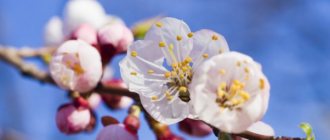Canadian roses are the best for growing in harsh climates with low winter temperatures and changeable weather. These include both climbing roses and hybrid tea, species and modern ones. Most varieties have been bred since the last century in Canada, which is where the collective name of these hybrids comes from. A feature of their selection is interspecific hybridization, which made it possible to impart winter-hardiness properties to roses: “Canadian” roses can withstand frost down to –45 ° C, so there is no clear boundary in their cultivation by region. If you are looking for unpretentious and spectacular roses for your collection, our catalog will help you get to know these beauties and decide on the choice of variety.
Advantages of roses of Canadian selection
Canadian roses can withstand temperatures as low as –40°C. Even if in winter their shoots freeze slightly (as a rule, to the level of snow), they recover quite quickly in the spring. This is the most important advantage of these attractive flowers.
With proper care, Canadian roses bloom (even in the shade!) from the beginning of summer until the onset of frost. Plants are less likely than other species to suffer from powdery mildew and black spot. And even an inexperienced gardener can propagate “Canadian flowers” from cuttings. They quickly take root and take root well.
Classification and description of varieties of Canadian roses
Roses of Canadian selection are divided into 2 series of varieties :
- Parkland (park) . The buds of these upright roses come in various colors, they have an exquisite shape, but there is no aroma. There are no climbing specimens among the plants in this series.
- Explorer . The word “explorer” is translated as “researcher,” so the varieties of roses in this series are named after the discoverers and explorers of Canada (for example, John Davis roses). These roses are branched and climbing bushes, and their buds exude a pleasant, rich aroma.
Also, Canadian roses can be divided into 3 groups:
- climbing;
- hybrids of Rosa rugosa;
- hybrids of species roses and modern varieties.
Climbing Canadian roses
Most Canadian climbing roses are bred using Cordes rose hybrids. As a rule, shoots older than 3 years are removed every spring. If they are not pruned, an overly spreading bush with long (about 2 m) shoots will grow.
Quadra
This Canadian park rose reaches a height of 1.5-1.8 m. It blooms for a long time and repeatedly with dense double red flowers (up to 8 cm in diameter). Each brush contains from 1 to 4 flowers.
Felix Leclerc Rose
This climbing rose was bred in 2007. Its shoots can reach a height of 3 m. Moreover, the plant does not need pruning to stimulate growth. The rose has bright pink flowers and can withstand frosts only down to –30°C.
John Davis
In warm years, this rose blooms early, profusely and for a long time. It is grown as a scrub or climbing rose. The reddish-pink buds exude a spicy-fruity aroma.
Champlain
This winter-hardy and disease-resistant hybrid from the Explorer series was bred in 1982. Rose Champlain is similar to floribunda. Its bright red semi-double flowers (with a bunch of bright yellow stamens in the center) are arranged in racemes of 5-7 pieces. Flowering is observed until frost.
Features of the variety
Experienced flower growers know that caring for ornamental plants takes a lot of time and effort. In addition, not all flowers are able to survive in harsh climates. Canadian breeders have developed varieties of roses that are resistant not only to cold weather, but also to powdery mildew. Here are their main advantages:
- long flowering period;
- pleasant but unobtrusive aroma;
- ability to propagate by cuttings;
- no difficulties in care;
- the ability to plant in open ground, even in cold regions;
- well suited for creating hedges.
Pink Canadian
In addition, the Canadian rose does not require additional shelter during cold weather. The flower has a double or semi-double texture. There are buds in white, pink, red, cream and salmon shades.
Attention! In the descriptions of nurseries, the Canadian rose is called unpretentious and resistant to cold. Of course, success largely depends on the specific site and microclimate of the region.
The seedlings feel great even in northern latitudes. These flowers can decorate any garden.
Frost resistance
Canadian rose, as a rule, looks more modest than other varieties, but can withstand even 30-degree frost. This flower really does not require covering from spunbond or spruce branches. The flowering period begins in the first days of summer and ends with the onset of the first frost.
In the first winter, to be on the safe side, it is necessary to cover the base of the bush with sand and earth in equal parts.
Lush flowering
Roses of Canadian selection are resistant to weather changes. They are able to bloom luxuriantly all summer. The leaves of the plant are rich green. The variety of shades and small number of thorns have made these varieties popular among florists and decorators. Flowering can continue until frost. Its start depends on the region.
Note! Canadian roses have two waves of flowering. The second lasts less. However, the flowering is not so abundant.
Recovery after frost
Breeders from Canada have long worked to develop roses that can withstand extreme cold. As a result, scientists have discovered flowers with excellent regenerative abilities. Rapid recovery after cold weather is inherent in the genotype of the plant. If the crown freezes completely, branches can grow back from renewal buds on the roots.
Disease resistance
Canadian roses are an excellent solution for novice gardeners and those who do not want to spend a lot of time caring for their flower beds. This unpretentious plant is famous for its increased resistance to disease.
Some varieties of Canadian roses are often attacked by pests, most often the green rose aphid. For prevention purposes, it is necessary to treat the plant with systemic or contact insecticides.
Growing is quite simple
Hybrids of rugose rose (rugosa)
Representatives of this series are characterized by the beautiful shape of the bush and the leafy lower part of the plant. These roses are suitable for creating borders, hedges, round and oval flower beds, as well as the background part of a mixborder. To ensure continuous flowering and maintain the decorative appearance of the bush throughout the season, faded inflorescences must be trimmed in a timely manner.
Martin Frobisher
This is the first variety in the Explorer series, released in 1968. The rose is a spreading bush (up to 1.7 m high) with upright growing shoots, which are strewn with pale pink flowers 5-6 cm in diameter all summer.
Henry Hudson
This rose with numerous semi-double pinkish-white flowers is used mainly for creating hedges and curtains. Bush height – up to 1 m.
Modern hybrids of species of Canadian roses
These roses were bred from native species found in Alaska. The plants turned out to be compact, they look like floribundas and hybrid tea roses. Also in this group are scrubs that can grow like climbing roses.
Emily Carr
This variety was bred in 2007, and it went on sale in 2010. The plant is distinguished by reddish young shoots and crimson flowers, like hybrid tea roses.
Adelaide Hoodless
The bush reaches a height of 1 m. Against the background of beautiful foliage there are bright semi-double flowers, collected in lush inflorescences (each with up to 30 flowers). Flowering is observed all summer, but is especially lush at the beginning and end of the season.
Prairie Joy
The bush is very elegant, reaching a height of 1.5 m. From late spring to autumn, the plant is strewn with pink flowers of a classical shape.
Morden Cardinette
The compact bush grows only up to half a meter in height, so this rose looks great as a potted plant. Scarlet flowers, collected in inflorescences, adorn the bush all summer.
Morden Sunrise
This yellow park rose reaches a height of 0.8 m. Glossy dark green foliage beautifully sets off the delicate peach color of the flower. Flowering continues all summer. The plant is resistant to fungal diseases.
From amateur gardeners
Some more reviews on varieties. Nadezhda (Nadezhda) - reviews from gardeners about this variety are only positive. It is believed that this variety is simply a godsend, since it takes root in any conditions and is not fussy to care for. The only caveat is that it blooms later compared to other varieties.
A resident from the city of Khanty-Mansi Autonomous Okrug-Yurga, grows the following varieties: Moden Blanche, Morden Sunrise, Winniper Park, Hope for Humanity. Their winters are harsh, but snowy. Covers the bushes with spruce branches and potato tops. For two years, roses winter well.
Caring for Canadian roses
Planting and caring for “Canadian roses” are practically no different from the agricultural techniques of other roses. In a lighted area, dig a planting hole up to 70 cm deep and fill it with light, fertile soil. After planting the seedling, the soil is regularly watered and mulched.
When growing Canadian roses in harsh weather conditions, it is recommended to cover young plants for the winter, and in preparation for wintering, you need to cut out non-woody shoots. Otherwise, frost will destroy them and thereby weaken the plant.
In the spring, before the buds open, sanitary pruning is carried out: frozen and weak internal shoots are removed, as well as dry stumps remaining after the previous pruning. Old shoots are cut out onto the stump every few years to rejuvenate the bush.
To achieve lush flowering, it is recommended to apply nitrogen fertilizers (20-30 g of urea) in the spring, and feed the bushes with phosphorus (30 g of superphosphate) and potassium (20 g of potassium magnesium) in mid-summer.
Despite their excellent frost resistance, in the fall in the northern regions it is better to cover Canadian roses well with peat or compost (2-3 buckets), and during the winter throw snow on the bushes. In climbing roses, it is advisable to bend the shoots to the ground.
How to land
The Canadian rose is quite easy to grow and breed: it quickly gets along with neighboring flowering crops. In this case, everything will depend only on the features of the composition.
Choosing the right seedling
For planting, it is important to choose seedlings with long and strong legs. You need to remove excess leaves from the shoots, except for the top couple. The seedlings should have small roots: it is important not to damage them during planting in the soil.
The best time to plant roses is autumn . Over the winter, the roots of the seedling will have time to strengthen and develop well, delighting the gardener with strong branches in the spring. Canadian roses love full sun, but don't need to be planted in a direct source of bright light. The best place in this case would be a ventilated area with a little shade .
Experts do not recommend planting roses on the south side of the house. Under the influence of sunlight in winter, the mass of snow in such places quickly thaws and freezes again. Such temperature changes lead to freezing of plant shoots.
Preparing the soil mixture
Before planting, you need to prepare the site and soil mixture in advance. A common hole is dug with a diameter of 70*70 centimeters. The hole should be filled with loose and non-acidic soil, fertilized with an organic and mineral composition. It is recommended to use peat, humus or fine wood ash as organic matter. After planting is completed, it will be better to hill up the seedlings.
Features of care
The plant is not at all capricious. The main care will take place in spring and summer. Minimal requirements for watering, proper pruning, light shelter for the winter - that's all the plant needs.
The rose is very often mentioned as a Christian symbol. In the Middle Ages, Christians interpreted such a symbol as heavenly bliss, consolation and faith. Also, Saint Cecilia often wore a wreath of roses.
Watering roses continues from spring to summer inclusive. You need to water the plant in the mornings or evenings several times a week. During regular rains, the plant should not be watered. It is also important to ensure that the soil near the plant is moist. Water the rose at the root, while trying not to get it on the shoots and leaves of the plant. At the end of summer and with the beginning of autumn, watering stops to prevent late shoots from growing. You should start fertilizing roses the next year after planting. In spring, you need to apply liquid mineral fertilizer after watering the crop.
Pruning young bushes
Every year the rose bush requires pruning. Old and damaged branches, as well as overgrown shoots, should be trimmed. This is how you will get a beautiful crown and direct all the nutrients to the development of flowering branches and buds. After flowering, you need to cut off all the branches that no longer produce inflorescences. All cut areas must be treated with garden varnish.











